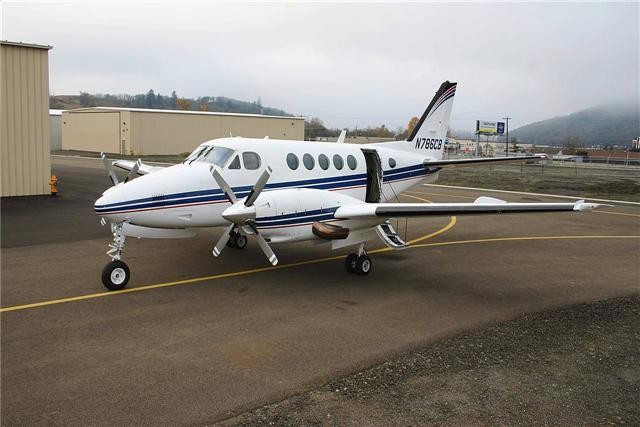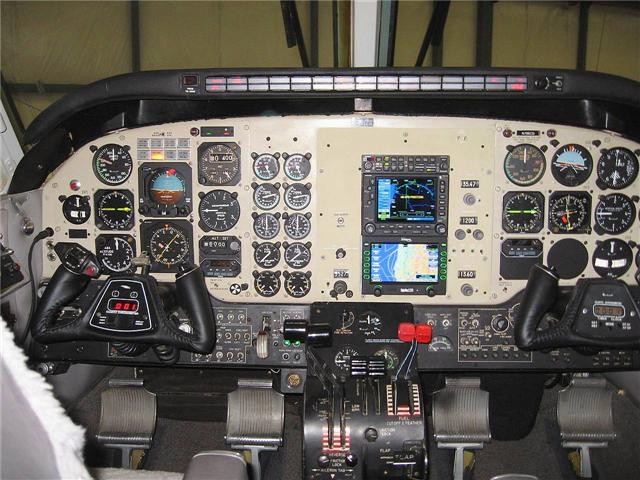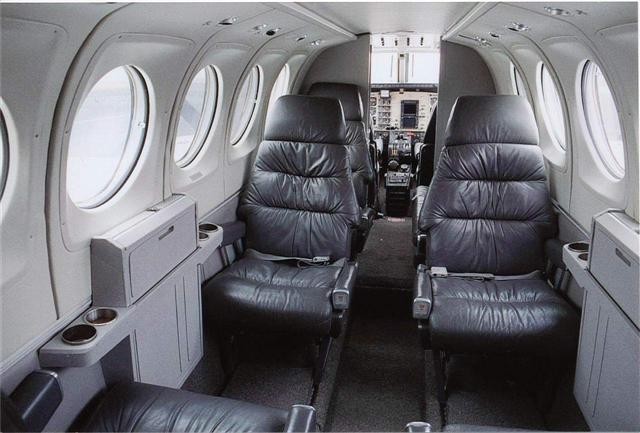


Aircraft Description
Background/History
In January 1964, the first Beechcraft 65-90 took to the air. Based on the piston-engined Model 65 Queen Air, the -90 featured the then-new Pratt & Whitney Canada PT6A turboprop powerplants in place of the earlier 65’s Lycoming flat-six piston engines. A pressurized model was developed, and was designated the King Air 90. Many variants followed including the PT6A-20-powered A90 and B90, and the C90 powered by the -21 variant of the PT6A. In 1969, Beech introduced the Model 100 King Air. It featured a 4.2ft. stretch of the -90’s fuselage, a new wing derived from the wing of the Model 99 Airliner, and enlarged tail surfaces. In October 1972 Beech began deliveries of the A100, whose detail refinements included four-bladed propellers which significantly decreased cabin noise levels. Following a strike at Pratt & Whitney which interrupted delivery of PT6A engines, Beech selected the Garrett TPE331 series engine to power the new B100 King Air, whose first flight was in March 1975, with first deliveries in 1976. Collins avionics were offered as standard equipment. The success of the larger 200-series King Air models led to the end of production of the B100 in 1983, after 137 units had been delivered.
Power
The Beech King Air B100 is powered by a pair of Garrett TPE 331-6-252B turboprop engines producing 715 shaft horsepower driving Hartzell four-bladed, full feathering, reversible, constant speed propellers. Inspection interval on the engines is 5,400 hours.
Avionics
Standard equipment on the King Air B100 included Collins radios. A typical installation includes dual VHF 20 comms, dual VIR 30 navs, Collins ADF 60A, dual Collins TDR 90 transponders, Sperry SPZ 200A flight director/autopilot system, and the Sperry Primus 300 CLR weather radar.
Design Features
The King Air B100 is a pressurized, twin-engine turboprop business aircraft configured as a cantilever low-wing monoplane with a conventional tail. The retractable tricycle landing gear utilizes dual wheels on the main gear, and a single whele on the nose gear. A large airstair door is located on the port side of the fuselage, aft of the wing. The B100 utilizes dual engine bleed air for pressurization and cabin heat, with supplemental heat provided by an electric heating system. Full anti-ice and de-ice systems include pneumatic boots on the wing and tail leading edges, electric propeller anti-ice, and electrically heated windshields, pitot, and fuel vents.
Accomodations
The King Air B100’s flexible seating system allows for a variety of cabin configurations, but the most common arrangement seats seven, including the belted lavatory seat. A 62 cu.ft. baggage compartment is located in the aft cabin. Noise levels are significantly lower than those of previous King Airs, largely due to the use of four-bladed propellers. Cabin height is 4.8ft., width is 4.5ft., and cabin length is 16ft.
| General | King Air B100, BE-100 | |||
|---|---|---|---|---|
| Category | Multiengine Turboprop < 12,500 lbs. | |||
| Years Aircraft Manufactured | 1976 – 1983 | |||
| Serial Number Range | BE-1 – BE-137 | |||
| Retail High Price | $1,100,000.00 / 863,170.00€ | |||
| Retail Low Price | $379,000.00 / 297,401.30€ | |||
| Characteristics | King Air B100, BE-100 | |||
| Seating | 1 + 8/10 | |||
| Wing Loading | 42.2 | |||
| Power Loading | 8.3 | |||
| Noise(EPNdB): Takeoff/Sideline/Approach | 77.3 | |||
| External Dimensions (ft) | King Air B100, BE-100 | |||
| External Length | 39.9 | |||
| External Height | 15.4 | |||
| External Span | 45.9 | |||
| Internal Dimensions (ft) | King Air B100, BE-100 | |||
| Internal Length (Overall/Net Height) | 16.7 | |||
| Internal Height | 4.8 | |||
| Internal Width (Max/Floor) | 4.5 | |||
| Baggage | King Air B100, BE-100 | |||
| External: Cu.Ft./Lb. | N/A | |||
| External: Cu.Ft./Lb. | N/A | |||
| Power | King Air B100, BE-100 | |||
| Engines | 2 Hon TPE331-6-252B | |||
| Output (lbs ea.)/Flat Rating | 715shp | |||
| Inspection Interval | 5,400t | |||
| Data based on latest manufactured year | ||||



